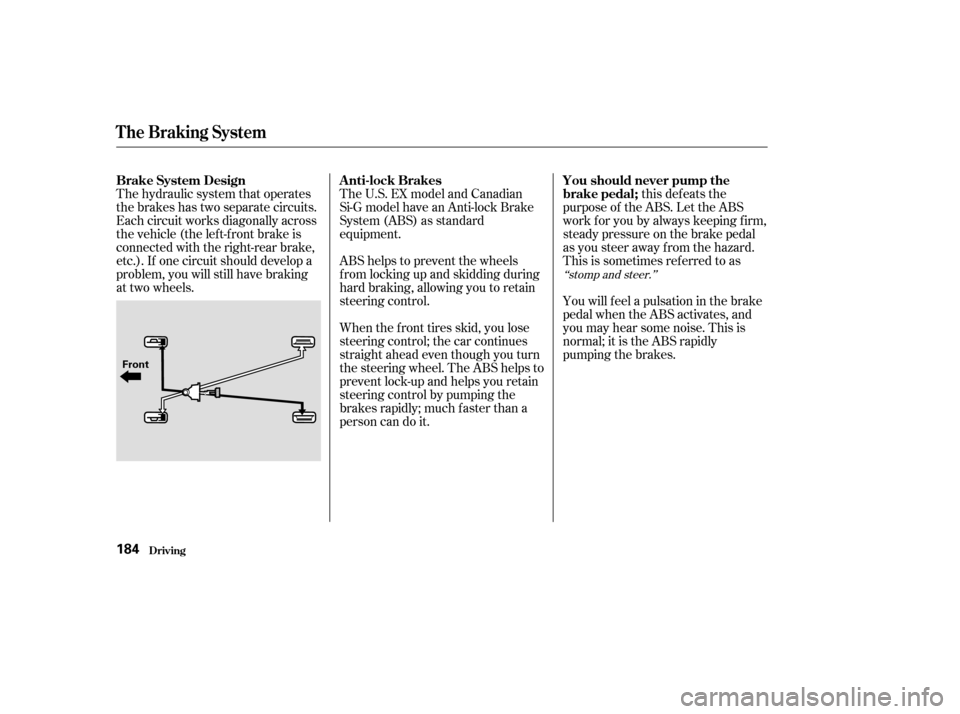Page 5 of 302
Your car is equipped with many
features that work together to
protect you and your passengers
during a crash.
Some saf ety f eatures do not require
anyactiononyourpart.These
include a strong steel f ramework
that forms a safety cage around the
passenger compartment; f ront and
rear crush zones that are designed to
crumple and absorb energy during a
crash; a collapsible steering column;
and seat belt tensioners that
automatically tighten the front seat
belts in the event of a crash.
CONT INUED
Driver and Passenger Saf ety
Your Car’s Saf ety Features
7
(7)(11)(9) (2)
(8)
(6)
(4)
(3)
(1)
(8)
(10)
(7)
(5)
(2)
(1) Safety Cage
(2) Crush Zone
(3) Seats and Seat-Backs
(4) Head Restraints
(5) Collapsible Steering Column
(6) Seat Belts
(7) Front Airbags
(8) Side Airbags (Optional)
(9) Seat Belt Tensioners
(10) Door Locks
(11) Seat Belt Buckle Tensioners
�����—�����—�����y�
�������������y���
�(���%�������y�����
���y
Page 9 of 302

Head restraints can help protect you
f rom whiplash and other injuries. For
maximum protection, the back of
your head should rest against the
center of the head restraint.Move the f ront
seats as far back as possible, and
keep adjustable seat-backs in an
upright position whenever the car is
moving. Keeping your doors locked reduces
thechanceof beingthrownoutof
the car during a crash. It also helps
prevent occupants f rom accidentally
opening a door and f alling out, and
outsiders f rom unexpectedly opening
your doors.
Your car’s seats are designed to keep
you in a comf ortable, upright
position so you can take f ull
advantage of the protection offered
by seat belts and the energy
absorbing materials in the seats.
How you adjust your seats and seat-
backs can also affect your safety. For
example, sitting too close to the
steering wheel or dashboard
increases the risk of you or your
passenger being injured by striking
theinsideof thecar,orbyan
inf lating airbag.
Reclining a seat-back too f ar reduces
the seat belt’s ef f ectiveness and
increases the chance that the seat’s
occupant will slide under the seat
belt in a crash and be seriously
injured. Head Restraints
Door L ocks
Seats and Seat-Backs
What you should do:
Driver and Passenger Saf ety
Your Car’s Saf ety Features
11
�����—�����—�����y�
���������
���y���
�(���%�������y�����
���y
Page 62 of 302

This light has two f unctions:This indicator comes on when you
turn the ignition switch ON (II). It
is a reminder to check the parking
brake. Driving with the parking
brake not f ully released can
damage the brakes and tires.
If the indicator remains lit after
you have f ully released the
parking brake while the engine is
running, or if it comes on while
driving, it can indicate a problem
in the brake system. For complete
inf ormation, see page . This indicator lights when you turn
the ignition switch to ON (II) with
the headlight switch of f and the
parking brake set. It should go of f if
youturnontheheadlightsorrelease
the parking brake. If it comes on at
any other time, it means there is a
problem with the DRL. There may
also be a problem with the high
beam headlights.
This light normally comes on f or a
f ew seconds when you turn the
ignition switch ON (II), and when
the ignition switch is turned to
START (III). If this light comes on at
any other time, there is a problem in
theABS.If thishappens,takethe
cartoyourdealertohaveitchecked.
With the light on, your car still has
normal braking ability but no anti-
lock. For complete inf ormation, see
page .
1. 2.
186
275
Canadian models only
Only on models equipped with ABS (see
page ) 184
CONT INUED
Parking Brake
and Brake
System
Indicator ‘‘Daytime Running
Lights’’ Indicator
Anti-lock Brake System
(A BS) Indicator
Indicator L ights
Inst rument s and Cont rols65
U.S. Canada
�����—�����—�����y�
����
����
���y���
�(���%�������y���������y
Page 108 of 302
This section covers how to set up the
system controls f or ventilation,
heating, cooling, dehumidif ying, and
def rosting.
The engine must be running f or the
heater and air conditioning to
generate hot and cold air. The heater
uses engine coolant to warm the air.
If the engine is cold, it will be several
minutes bef ore you f eel warm air
coming from the system.
You can adjust the direction of the
air coming f rom the dashboard vents
by moving the tab in the center of
each vent up-and-down and side-to-
side. The air conditioning does not rely on
engine temperature.
The vents in the corners of the
dashboard can be opened and closed
with the dials underneath them.
Heating and Cooling
Comf ort and Convenience Feat ures
Vent Controls
How to Use the System
112
SIDE VENT
Open Close
TABS
CENTER VENTS
�����—�����—�����y�
����
��������y���
�(���%�������y���
�
���y
Page 163 of 302
The hooks on the f loor of the cargo
area enable you to tie down items
stored in the back. Make sure all
stored items are secured bef ore
driving.You can use the cargo net to secure
items in the cargo area. To install the
cargo net, hook the loops on the f our
corners of the net to the tabs on both
sides of the trunk.On EX model in the U.S., and Si model
in Canada
Cargo Hooks Cargo Net
Carrying Cargo
Bef ore Driving168
�����—�����—�����y�
�������������y���
�(���%�������y���
���
�y
Page 178 of 302

The hydraulic system that operates
the brakes has two separate circuits.
Each circuit works diagonally across
the vehicle (the lef t-f ront brake is
connected with the right-rear brake,
etc.). If one circuit should develop a
problem, you will still have braking
at two wheels.this defeats the
purpose of the ABS. Let the ABS
work f or you by always keeping f irm,
steady pressure on the brake pedal
as you steer away from the hazard.
This is sometimes ref erred to as
You will f eel a pulsation in the brake
pedal when the ABS activates, and
you may hear some noise. This is
normal; it is the ABS rapidly
pumping the brakes.
The U.S. EX model and Canadian
Si-G model have an Anti-lock Brake
System (ABS) as standard
equipment.
When the f ront tires skid, you lose
steering control; the car continues
straightaheadeventhoughyouturn
the steering wheel. The ABS helps to
prevent lock-up and helps you retain
steering control by pumping the
brakes rapidly; much f aster than a
person can do it.
ABS helps to prevent the wheels
f rom locking up and skidding during
hard braking, allowing you to retain
steering control.
‘‘stomp and steer.’’
Brake System Design A nti-lock Brakes You should never pump the
brake pedal;
The Braking System
Driving184
Front
�����—�����—�����y�
������
��
���y���
�(���%�������y���
�����y
Page 179 of 302

on loose or
uneven surf aces, such as gravel or
snow, than a vehicle without anti-
lock. Slow down and allow a greater
distance between vehicles under
those conditions.
it
only helps with steering control
during braking. You should always
maintain a saf e f ollowing distance
f rom other vehicles.
such as trying to take a
corner too f ast or making a sudden
lane change. Always drive at a safe,
prudent speed f or the road and
weather conditions.
Always steer moderately
when you are braking hard. Severe
or sharp steering wheel movement
can still cause your car to veer into
oncoming traffic or off the road.
Activation varies with the amount of
traction your tires have. On dry
pavement, you will need to press on
thebrakepedalveryhardbeforeyou
activate the ABS. However, you may
feel the ABS activate immediately if
you are trying to stop on snow or ice.
CONT INUED
A vehicle with A BS may require a
longer distance to stop
A BS does not reduce the time or
distance it takes to stop the car;
A BS will not prevent a skid that
results f rom changing direction
abruptly,
A BS cannot prevent a loss of
stability.Import ant Saf et y Reminders
The Braking System
Driving185
�����—�����—�����y�
������
������y���
�(���%�������y���
�����y
Page 180 of 302
The ABS is self -checking. If anything
goes wrong, the ABS indicator on
the instrument panel comes on (see
page ). This means the anti-lock
f unction of the braking system has
shut down. The brakes still work like
a conventional system without anti-
lock, providing normal stopping
ability. You should have the dealer
inspect your car as soon as possible.65
U.S. EX and Canadian Si-G
A BS Indicat or
The Braking System
Driving186
ABS INDICATOR
�����—�����—�����y�
������
������y���
�(���%�������y���
�����y